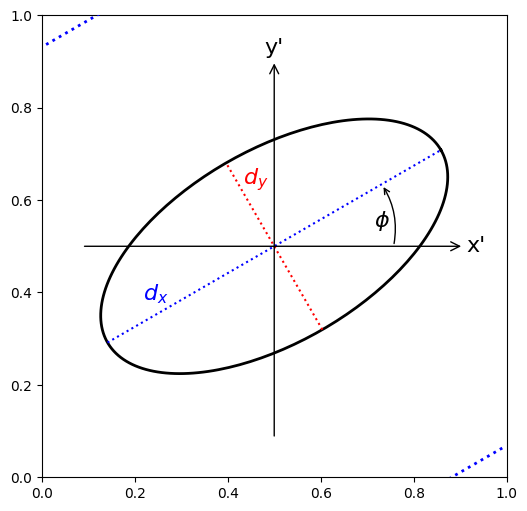ISO 11146 Beam Size Definitions
Scott Prahl
Sept 2023
A laser beam will usually consist of a superposition of several modes. A single mode beam radius is easily described by \(1/e^2\) points. This, of course, fails for any beam shape other than Gaussian. ISO 11146 is intended to provide a simple, consistent way of describing the width of a beam.
This notebook summarizes the mathematical definitions.
[1]:
import numpy as np
import matplotlib.pyplot as plt
import laserbeamsize as lbs
[2]:
lbs.plot_beam_diagram()

The total power \(P\) is obtained by integrating the irradiance \(E(x,y)\) over the entire beam
Center of beam
The center of the beam can be found by
and
Variance
A useful parameter characterizing a general two-dimensional distribution \(E(x,y)\) is the variance in the \(x\) and \(y\) directions
and
and
In general, \(\sigma_x \ne \sigma_y\). For example, in semiconductor lasers the height and width of the emitting aperture differ. Such beams are called astigmatic.
Now, the quantities \(\sigma_x^2\) and \(\sigma_y^2\) will always be positive, but \(\sigma_{xy}^2\) can be negative, zero, or positive.
Beam Radius and \(D4\sigma\) or D4sigma
For a Gaussian distribution centered at (0,0) with \(1/e^2\) radius \(w\) we find
This leads to the definition of the beam radius definition as adopted by ISO 11146,
\(D4\sigma\) or D4sigma
The \(D4\sigma\) beam diameter is a simple rearrangement of the above equation in which it is noted that twice the radius or the beam diameter is equal to \(4\sigma\)
Relationship to FWHM
Sometimes it is the full width at half maximum (FWHM) value that is desired or known. In general, there is no direct relationship between the \(1/e^2\) radius \(w\) and the FWHM. However, in the special case of a Gaussian beam, there is.
Major and minor axes of an elliptical beam
The \(x\)-axis diameter \(d_x=2w_x\) is given by
and similarly \(d_y=2w_y\) is
except if \(\sigma_x^2=\sigma_y^2\) in which case
and
The tilt angle of the ellipse \(\phi\)
This is measured as a positive angle counter-clockwise from the \(x\)-axis (see figure above).
where we use np.arctan2(numerator,denominator) to avoid division by zero when \(\sigma_x^2=\sigma_y^2\)
Ellipticity and Eccentricity
The ellipticity \(e\) is
and the eccentricity is